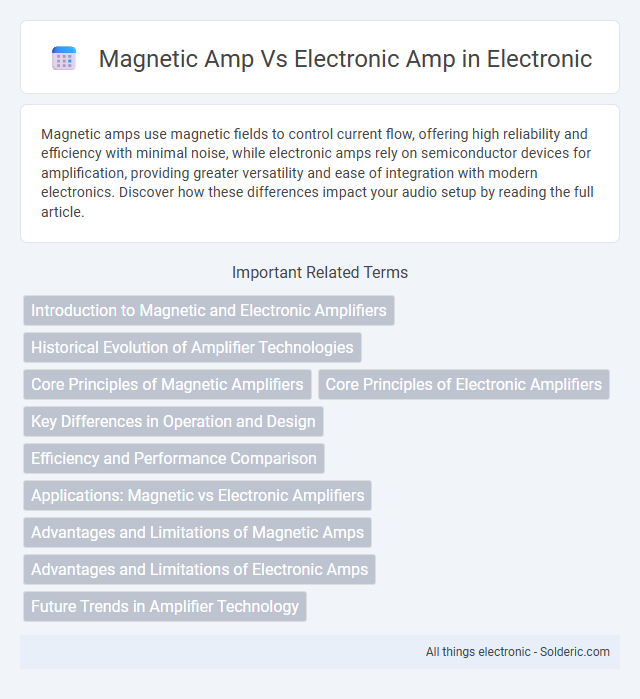Magnetic amps use magnetic fields to control current flow, offering high reliability and efficiency with minimal noise, while electronic amps rely on semiconductor devices for amplification, providing greater versatility and ease of integration with modern electronics. Discover how these differences impact your audio setup by reading the full article.
Comparison Table
| Feature | Magnetic Amplifier | Electronic Amplifier |
|---|---|---|
| Operating Principle | Magnetic saturation control of inductors | Transistor or vacuum tube signal amplification |
| Power Efficiency | High efficiency at power conversion | Variable, generally lower in linear modes |
| Frequency Range | Low to medium frequencies (up to MHz) | Wide frequency range (Hz to GHz) |
| Output Power | High power handling capabilities | Wide range from low to high power |
| Size and Weight | Bulky and heavy due to magnetic cores | Compact and lightweight |
| Reliability | Robust, less prone to damage from electrical noise | Susceptible to component failures |
| Typical Applications | Power control, industrial, military | Audio, communication, consumer electronics |
| Cost | Higher initial cost due to materials | Generally lower, mass-produced components |
Introduction to Magnetic and Electronic Amplifiers
Magnetic amplifiers utilize the nonlinear properties of magnetic cores to control output signals, offering robust performance in high-power applications with excellent linearity and reliability. Electronic amplifiers rely on semiconductor devices like transistors and vacuum tubes to amplify electrical signals, providing greater bandwidth and faster response times ideal for audio and RF environments. Your choice between magnetic and electronic amplifiers depends on specific requirements such as power handling, frequency range, and system complexity.
Historical Evolution of Amplifier Technologies
Magnetic amplifiers, emerging in the early 20th century, relied on electromagnetic principles to modulate current and were widely used in industrial and military applications during the 1940s and 1950s. Electronic amplifiers, developed later with the advent of vacuum tubes and transistors, offered greater efficiency, compactness, and signal fidelity, leading to their dominance in audio and communication systems by the mid-20th century. Understanding the historical evolution of these amplifier technologies helps you appreciate the transition from bulky, magnetic-based designs to sleek, high-performance electronic circuits in modern devices.
Core Principles of Magnetic Amplifiers
Magnetic amplifiers operate based on the magnetic saturation properties of ferromagnetic cores, utilizing changes in core magnetization to control electrical signals without semiconductor devices. These amplifiers modulate alternating current through saturation and phase shift in the magnetic core, enabling robust and reliable amplification in high-power and high-temperature environments. Unlike electronic amplifiers, magnetic amplifiers rely on inductive coupling and magnetic hysteresis, offering advantages in durability and electromagnetic interference resistance.
Core Principles of Electronic Amplifiers
Electronic amplifiers operate by controlling the flow of electrons through semiconductor devices such as transistors or vacuum tubes, using an input signal to modulate a larger voltage or current output. Unlike magnetic amplifiers, which rely on the magnetic saturation of cores to amplify signals, electronic amplifiers utilize active components to achieve higher gain and broader frequency response. Understanding your electronic amplifier's core principle involves recognizing how voltage or current gain is produced by manipulating charge carriers within solid-state materials.
Key Differences in Operation and Design
Magnetic amps utilize magnetic fields and saturable reactors to control current flow, offering high reliability and low noise, while electronic amps rely on semiconductor components like transistors for amplification, enabling faster response and greater flexibility. The design of magnetic amps emphasizes robust construction with fewer electronic parts, making them less susceptible to electromagnetic interference, whereas electronic amps incorporate complex circuitry for precise signal processing and higher gain control. Choosing between these amplifiers depends on Your need for durability in harsh environments versus the demand for advanced features and compact size in modern applications.
Efficiency and Performance Comparison
Magnetic amplifiers provide high efficiency with minimal heat generation due to their solid-state design and lack of moving parts, making them ideal for power regulation in harsh environments. Electronic amplifiers, especially transistor-based models, offer superior performance with faster response times and greater linearity, enabling precise signal amplification in audio and communication systems. While magnetic amps excel in durability and efficiency under heavy loads, electronic amps dominate in versatility and high-frequency applications.
Applications: Magnetic vs Electronic Amplifiers
Magnetic amplifiers excel in industrial applications requiring high reliability and resistance to radiation, such as power control in heavy machinery and military equipment, due to their robust, passive components. Electronic amplifiers dominate in consumer electronics, audio systems, and telecommunications, offering greater amplification precision, compactness, and higher frequency response. When choosing an amplifier for your application, consider the operational environment and signal requirements to determine whether the durability of magnetic amplifiers or the versatility of electronic amplifiers best suits your needs.
Advantages and Limitations of Magnetic Amps
Magnetic amps offer superior tonal warmth and natural distortion, making them ideal for musicians seeking authentic sound reproduction. Their durability and simplicity reduce maintenance needs, but they tend to be heavier and less versatile compared to electronic amps. Understanding these limitations helps you choose the right amplifier for your specific sound preferences and performance requirements.
Advantages and Limitations of Electronic Amps
Electronic amplifiers offer advantages such as greater control over sound modulation, lighter weight, and enhanced portability compared to magnetic amplifiers. They provide higher fidelity and consistency in audio reproduction due to advanced circuitry and digital processing capabilities. Limitations include potential signal distortion at high volumes and susceptibility to electromagnetic interference, which can affect sound quality.
Future Trends in Amplifier Technology
Magnetic amplifiers are making a resurgence due to their robustness and energy efficiency, especially in industrial and high-power applications, while electronic amplifiers continue to dominate consumer electronics with advancements in digital signal processing and miniaturization. Future trends indicate a convergence where hybrid amplifiers combine the durability of magnetic designs with the precision and flexibility of electronic circuits to meet evolving demands for higher fidelity and lower power consumption. Your audio systems could benefit significantly from these innovations, offering improved performance and adaptability across diverse environments.
Magnetic amp vs Electronic amp Infographic

 solderic.com
solderic.com